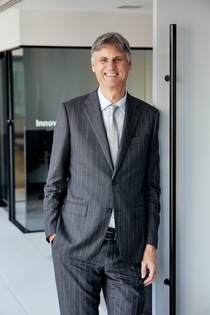Local Management Team
Our sub-regional leadership team provides focus for BASF in Australia and New Zealand. They provide the organisation with a vision, direction and collaborative framework that brings the diverse business and functional units together in one high-performing organisation.

David has been Chairman and Managing Director of BASF Australia and New Zealand since July 2016.
Prior to this, he was Head of Corporate Functions for Australia and New Zealand. This role included the subregional management of Finance, Tax, Supply Chain, Human Resources, Procurement, Real Estate and Information Management, as well as the country management operations of New Zealand.
David joined BASF in 1999 to run the Information Technology platform and its broadening to include Supply Chain. In 2004, he was appointed Director of the Service Platform and the directorships of BASF’s Australian companies in 2005.
Prior to BASF, David held a number of roles in a world-leading Australian subsidiary of a UK glass manufacturing business, including manufacturing management, strategy, business re-engineering, systems design and implementation.
David is a graduate of Monash University with bachelor degrees in Chemical Engineering and Science (Applied Mathematics). He holds a Master of Business Administration from Deakin University and is a graduate member of the Australia Institute of Company Directors.
David is the Chair of Chemistry Australia, member of the Australian Industry Group and CEO Forum, Trustee of the Committee for Economic Development of Australia and a Male Champion of Change.
He is married and has three children.




![Eine Fläche von rund 64.000 Quadratmetern - das entspricht 13 Fußballfeldern - umfasst der Steamcracker II, die größte einzelne Anlage am Standort Ludwigshafen der BASF. Der Cracker ist auch das „Herzstück" der Verbundproduktion. Seit 1981 ist dieser Gigant in Betrieb und spaltet unter Zusatz von Wasserdampf bei etwa 850 Grad Celsius Rohbenzin auf. Dabei entstehen im wesentlichen Ethylen und Propylen, beides unverzichtbare Grundstoffe für die Herstellung vieler Produkte in Ludwigshafen.
Abdruck honorarfrei. Copyright by BASF.
Steam cracker II, the largest individual plant at BASF's Ludwigshafen site, covers a surface area of about 64,000 square meters, which is about the size of 13 soccer fields. The steam cracker is also the heart of BASF's Verbund production strategy. This giant plant has been operating since 1981 and uses steam to crack naphtha at about 850°C [1,562°F]. This process leads primarily to ethylene and propylene, both indispensable feedstocks for manufacturing numerous products in Ludwigshafen.
Print free of charge. Copyright by BASF. Eine Fläche von rund 64.000 Quadratmetern - das entspricht 13 Fußballfeldern - umfasst der Steamcracker II, die größte einzelne Anlage am Standort Ludwigshafen der BASF. Der Cracker ist auch das „Herzstück" der Verbundproduktion. Seit 1981 ist dieser Gigant in Betrieb und spaltet unter Zusatz von Wasserdampf bei etwa 850 Grad Celsius Rohbenzin auf. Dabei entstehen im wesentlichen Ethylen und Propylen, beides unverzichtbare Grundstoffe für die Herstellung vieler Produkte in Ludwigshafen.
Abdruck honorarfrei. Copyright by BASF.
Steam cracker II, the largest individual plant at BASF's Ludwigshafen site, covers a surface area of about 64,000 square meters, which is about the size of 13 soccer fields. The steam cracker is also the heart of BASF's Verbund production strategy. This giant plant has been operating since 1981 and uses steam to crack naphtha at about 850°C [1,562°F]. This process leads primarily to ethylene and propylene, both indispensable feedstocks for manufacturing numerous products in Ludwigshafen.
Print free of charge. Copyright by BASF.](/api/imaging/focalarea/16x9/210x/dam/jcr%3Ab51d7c76-7ee8-35be-8c71-0a673246a35a/Ludwigshafen%20%20Steamcracker.jpg)